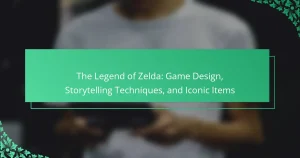Final Fantasy VI offers an unparalleled RPG experience through its deep narrative, rich character arcs, and innovative gameplay mechanics. The game explores themes of loss, rebellion, and redemption while featuring profound character development. It introduces gameplay innovations like the Active Time Battle system and the customizable Esper system. Together, these elements create a memorable journey that engages players on multiple levels.
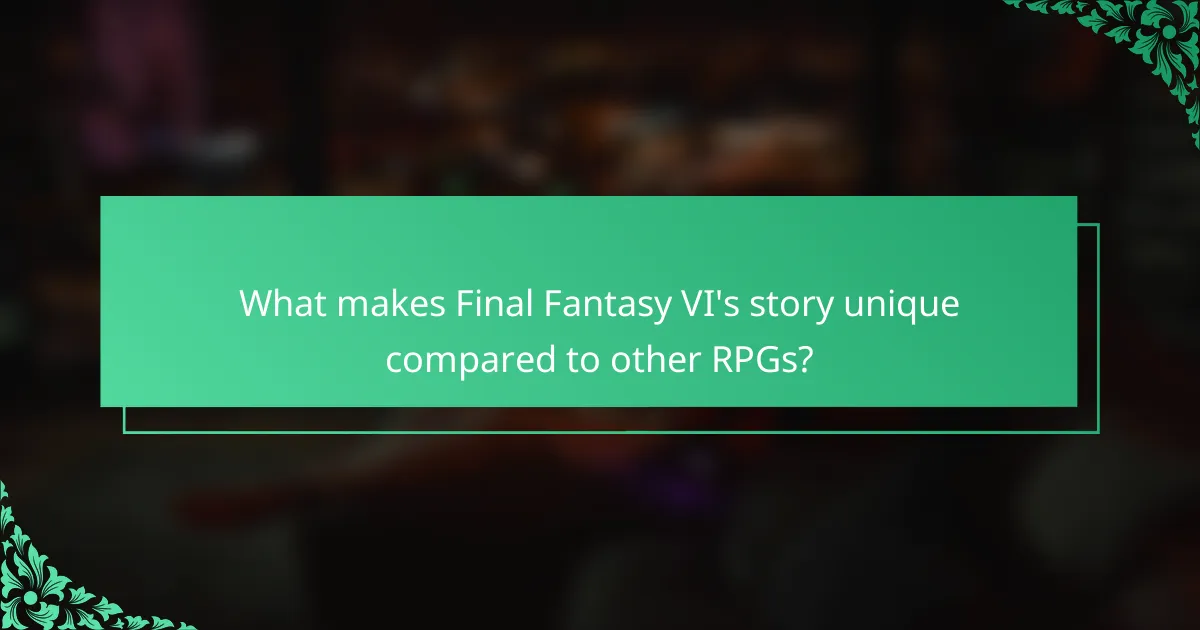
What makes Final Fantasy VI’s story unique compared to other RPGs?
Final Fantasy VI’s story is unique due to its deep narrative, rich character arcs, and innovative gameplay mechanics. The game explores themes of loss, rebellion, and redemption, setting it apart from typical RPGs. Character development is profound, with each character having distinct backstories and motivations that intertwine with the main plot. This complexity allows for emotional engagement, as players form connections with the characters.
Moreover, the gameplay innovations, such as the Active Time Battle system and the ability to customize characters with different abilities, enhance player agency. The game’s narrative structure, which includes multiple perspectives and non-linear storytelling, further distinguishes it. Overall, Final Fantasy VI combines story depth, character development, and gameplay innovations to create a memorable RPG experience.
How does the narrative structure enhance player engagement?
The narrative structure in Final Fantasy VI significantly enhances player engagement by intertwining character development with a complex storyline. This approach allows players to form emotional connections with characters, deepening their investment in the plot.
The game employs a non-linear storytelling technique, which encourages exploration and discovery. Players experience multiple character arcs, each with unique backgrounds and motivations, enriching the overall narrative. This complexity keeps players intrigued and motivated to uncover each character’s fate.
Moreover, the use of thematic elements such as loss, redemption, and the struggle against oppression resonates with players on a personal level. As a result, the narrative structure not only captivates players but also fosters a memorable gaming experience that stands out in the RPG genre.
Which themes are explored throughout the game?
Final Fantasy VI explores themes of loss, redemption, and the struggle against oppression. The narrative delves into personal journeys, emphasizing character development and emotional depth. The game’s innovative gameplay mechanics enhance these themes, allowing players to experience the impact of choices and relationships. The interplay between technology and nature also serves as a backdrop for the characters’ struggles, highlighting the consequences of industrialization.
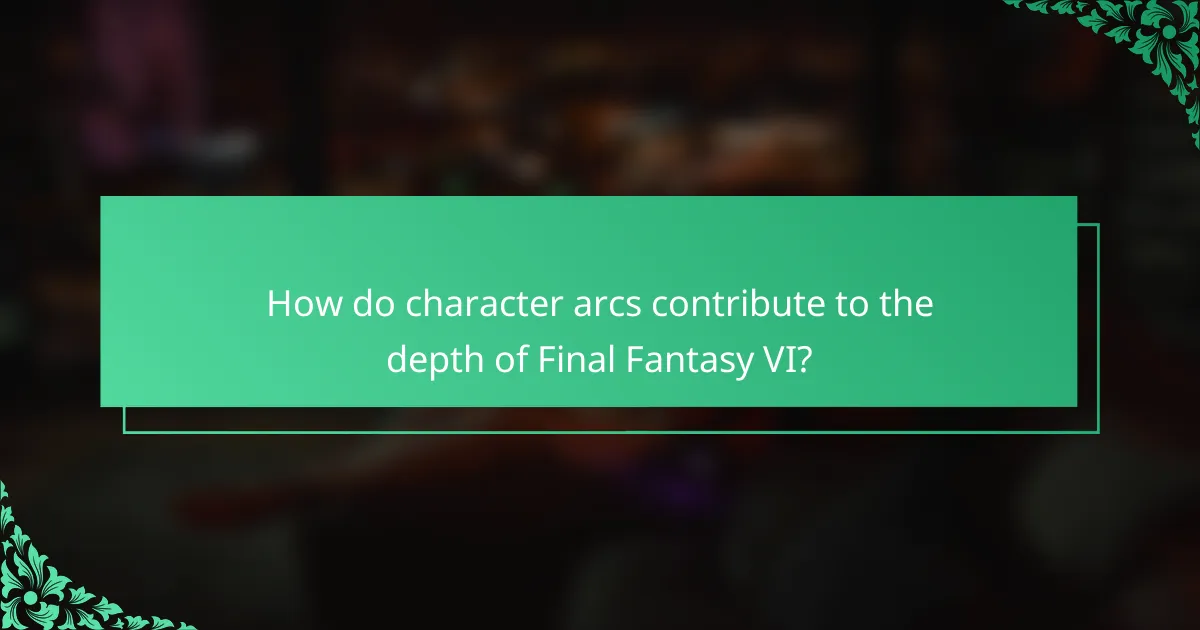
How do character arcs contribute to the depth of Final Fantasy VI?
Character arcs in Final Fantasy VI significantly enhance the game’s narrative depth. Each character undergoes personal growth, reflecting themes of loss, redemption, and identity. For instance, Terra Branford’s journey from confusion to self-acceptance embodies the struggle against oppression. This transformation allows players to connect emotionally, enriching the gameplay experience. Furthermore, characters like Locke Cole and Celes Chere showcase unique attributes, such as their distinct motivations and backgrounds, which contribute to the game’s multifaceted storytelling. The interplay of these arcs fosters a rich narrative tapestry, making Final Fantasy VI a landmark in character-driven storytelling.
What are the key character transformations in the game?
Key character transformations in Final Fantasy VI involve profound personal growth and development. Characters like Terra Branford evolve from uncertainty to self-acceptance, while Locke Cole transitions from a rogue to a committed protector. Each character faces unique challenges that catalyze these transformations, enhancing the narrative depth. Additionally, the interplay of relationships among characters, such as the bond between Celes Chere and her comrades, illustrates the theme of redemption and resilience, enriching the overall gameplay experience.
How do relationships between characters evolve?
Character relationships in Final Fantasy VI evolve through shared experiences, conflicts, and personal growth. Key interactions reveal deeper motivations and backgrounds, enhancing emotional connections. For instance, the bond between Terra and Locke develops as they confront their pasts together, showcasing themes of trust and redemption. Additionally, characters like Celes and Setzer experience a transformation in their dynamics, reflecting the game’s emphasis on collaboration and understanding. These evolving relationships significantly impact character arcs and gameplay, making them integral to the overall narrative depth.
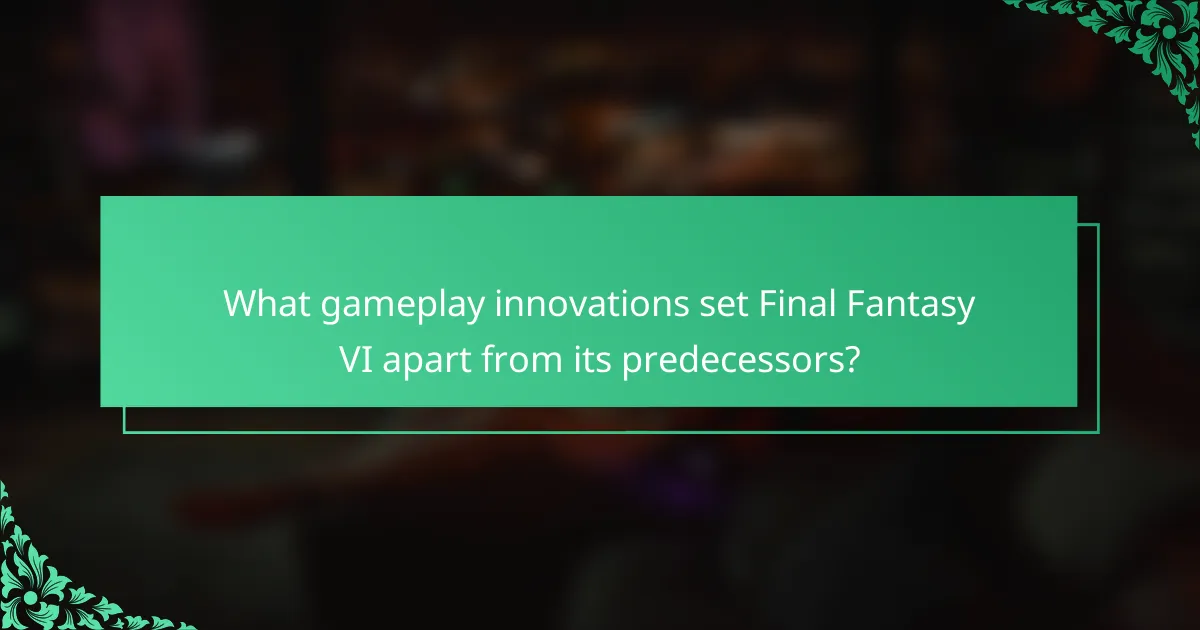
What gameplay innovations set Final Fantasy VI apart from its predecessors?
Final Fantasy VI introduced several gameplay innovations that distinguish it from earlier titles. The game features a unique character development system, allowing players to explore diverse abilities through the Esper system. This system enables characters to learn spells and enhance stats, providing a customizable experience. Additionally, the Active Time Battle (ATB) system adds real-time strategy elements, increasing engagement during combat. The narrative depth, including multiple character arcs and a non-linear storyline, also sets it apart, offering a richer emotional experience. Together, these innovations significantly elevate gameplay and storytelling.
How does the Active Time Battle system change player strategy?
The Active Time Battle system enhances player strategy by introducing real-time elements to turn-based combat. Players must make quick decisions while managing character actions and enemy movements. This dynamic encourages strategic planning and adaptability, as players must consider timing and resource management. The system differentiates Final Fantasy VI from traditional turn-based games, making each encounter more engaging and challenging. Players often develop unique strategies based on character abilities and enemy patterns, emphasizing the importance of quick thinking and foresight in gameplay.
Which unique mechanics enhance exploration and combat?
Unique mechanics in Final Fantasy VI enhance exploration and combat through a variety of innovative systems. The Active Time Battle system allows real-time decision-making, adding urgency to combat. The character-specific abilities, such as Gau’s Rage and Sabin’s Blitz, provide diverse combat strategies. Additionally, the world map features hidden areas and the ability to interact with the environment, enriching exploration. The narrative intertwines with gameplay, offering unique character interactions that impact both exploration and combat dynamics.
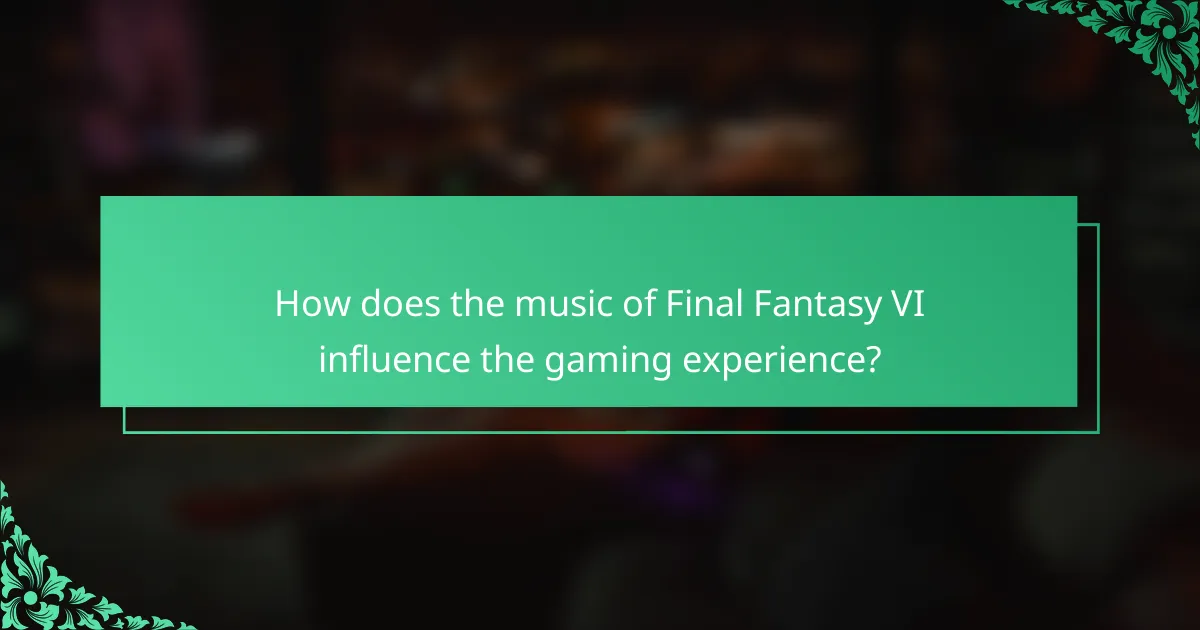
How does the music of Final Fantasy VI influence the gaming experience?
The music of Final Fantasy VI significantly enhances the gaming experience by immersing players in its emotional narrative. Composed by Nobuo Uematsu, the soundtrack features a rich variety of themes that reflect character development and story arcs. For example, the poignant melody associated with the character Terra captures her struggle and growth, deepening player connection. Additionally, the use of leitmotifs links specific pieces to characters and events, creating a cohesive storytelling experience. The music’s ability to evoke emotion contributes to memorable moments, making it a vital aspect of gameplay.
Which tracks are considered iconic and why?
Iconic tracks from Final Fantasy VI include “Terra’s Theme,” “Dancing Mad,” and “The Decisive Battle.” These pieces are celebrated for their emotional depth and innovative compositions.
“Terra’s Theme” captures the protagonist’s journey, blending nostalgia with hope. “Dancing Mad” stands out for its complex structure, reflecting the chaotic nature of the final battle. “The Decisive Battle” intensifies gameplay moments, enhancing player engagement through its powerful orchestration.
Each track contributes to the game’s storytelling, showcasing character development and thematic depth, solidifying their status as iconic in the gaming world.
How does the score affect emotional moments in the game?
The score significantly enhances emotional moments in Final Fantasy VI by intensifying player engagement. The game’s music, composed by Nobuo Uematsu, evokes profound feelings during key story events. For instance, the theme “Aria di Mezzo Carattere” plays during a pivotal scene, amplifying the emotional weight of character sacrifices. This unique attribute of the score creates lasting impressions, making moments memorable and impactful. As a result, players connect deeply with the narrative and characters, enhancing their overall experience.

What role does world-building play in Final Fantasy VI?
World-building in Final Fantasy VI creates a rich narrative landscape that enhances story depth, character development, and gameplay innovations. The game’s diverse environments, such as towns, dungeons, and the world map, provide context for character motivations and plot progression. Each location is meticulously designed, contributing to the game’s unique atmosphere and emotional resonance. The interplay between the world and its inhabitants allows players to explore themes of loss, hope, and rebellion, deepening their connection to the characters. This intricate world-building not only supports gameplay mechanics but also invites players to immerse themselves fully in the experience.
How do locations contribute to the overall storytelling?
Locations in Final Fantasy VI enhance storytelling by creating immersive environments that reflect character emotions and plot developments. Each locale serves as a backdrop for significant events, deepening the narrative. For example, the contrast between the serene Narshe and the chaotic Vector emphasizes the game’s themes of conflict and survival. The unique attributes of each location, such as the haunting ruins of the World of Ruin, evoke feelings of loss and nostalgia, enriching character arcs and player engagement. Overall, the diverse settings contribute to a cohesive and compelling story experience.
Which cultural references are embedded in the game’s design?
Final Fantasy VI incorporates various cultural references that enhance its narrative and character arcs. The game draws inspiration from steampunk aesthetics, reflecting a blend of technology and fantasy.
It references significant historical events, such as World War II, through its themes of war, oppression, and rebellion. Additionally, character designs and names often nod to real-world mythologies and literature, enriching player engagement.
The game’s soundtrack also features influences from classical music, which deepens the emotional resonance of key scenes. Overall, these cultural elements contribute to the game’s profound story depth and character development.
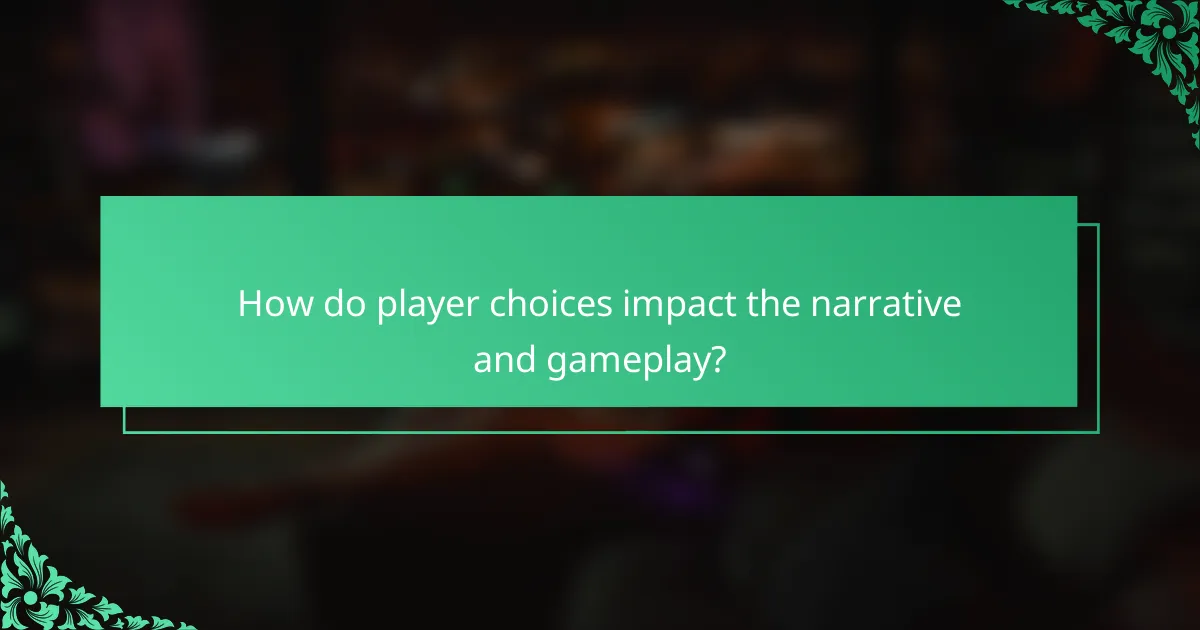
How do player choices impact the narrative and gameplay?
Player choices significantly shape both the narrative and gameplay in Final Fantasy VI. These decisions influence character relationships, plot outcomes, and the overall game experience.
The game features branching storylines, allowing players to affect character fates. For instance, choices during pivotal moments determine which characters join the party and their development arcs. The unique attribute of character death impacts player strategy and emotional engagement.
Additionally, gameplay mechanics like the “Espers” system are affected by player decisions. Players can choose how to utilize these powerful entities, which influences character growth and abilities. This interplay between choices and gameplay fosters a rich, immersive experience.
In summary, player choices in Final Fantasy VI create a dynamic narrative and gameplay environment, enhancing replayability and emotional investment.
What are the consequences of different character interactions?
Different character interactions in Final Fantasy VI significantly impact the narrative and gameplay experience. These interactions shape character development, influence story outcomes, and enhance player engagement.
Key consequences include character relationships evolving through dialogue choices, which can unlock unique abilities or story arcs. For instance, the relationship between Terra and Locke deepens through shared experiences, revealing their backstories and motivations.
Moreover, certain interactions can lead to rare events, such as character deaths or changes in party dynamics, affecting gameplay strategy. The game encourages exploration of these interactions, rewarding players with richer storytelling and emotional connections.
Overall, character interactions in Final Fantasy VI are pivotal, enhancing both the depth of the story and the complexity of gameplay.
How does the game encourage replayability through choices?
Final Fantasy VI encourages replayability through choices by allowing players to shape the narrative and character development. The game’s branching storylines and diverse character arcs create unique experiences based on player decisions. For example, players can choose different paths during key events, affecting alliances and story outcomes. This depth enhances engagement, motivating players to explore various scenarios and character interactions in multiple playthroughs. Additionally, the unique attributes of each character, such as their abilities and personal quests, further incentivize players to try different combinations and strategies.
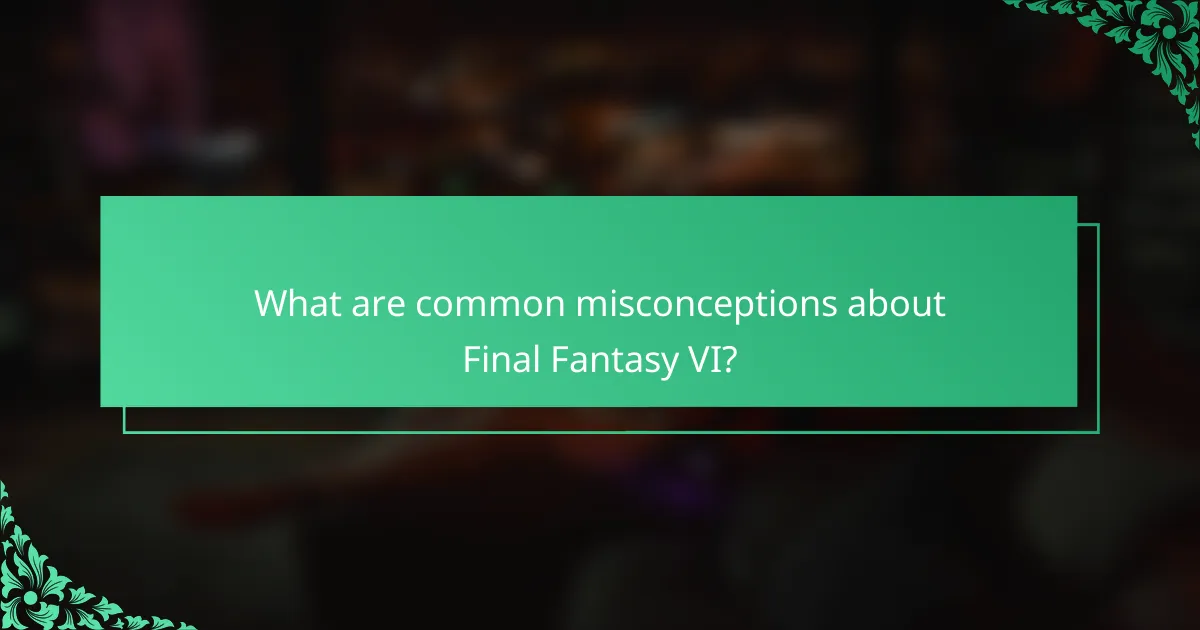
What are common misconceptions about Final Fantasy VI?
Many misconceptions exist about Final Fantasy VI, particularly regarding its gameplay and narrative. Some believe it lacks depth due to its 16-bit graphics, but the story is rich and emotionally engaging. Others think character development is shallow; however, each character has a unique backstory and growth arc. Additionally, some assume the gameplay is linear, while it actually features diverse exploration and multiple paths. These misconceptions overlook the game’s innovative mechanics and profound themes, which have contributed to its lasting legacy in the RPG genre.
Which elements are often misunderstood by new players?
New players often misunderstand the depth of character relationships and the impact of choices in Final Fantasy VI. The game features intricate storylines that intertwine characters’ backgrounds, which can be overlooked. Players may also misinterpret the significance of gameplay innovations, such as the Active Time Battle system, which alters strategic planning. Understanding these elements enhances the overall experience and reveals the game’s complexity.
How does the legacy of Final Fantasy VI influence modern RPGs?
Final Fantasy VI significantly influences modern RPGs through its intricate storytelling, character arcs, and gameplay innovations. The game’s narrative depth, featuring themes of loss and redemption, set a benchmark for emotional engagement in RPGs. Its character development allowed players to connect with a diverse cast, each with unique backstories and motivations, enhancing player investment.
Gameplay innovations, such as the Active Time Battle system, introduced strategic elements that are now staples in the genre. The game’s ability to blend traditional turn-based mechanics with real-time elements paved the way for hybrid systems in contemporary RPGs. As a result, Final Fantasy VI remains a foundational influence, shaping narrative complexity and gameplay design in modern role-playing experiences.
What best practices can enhance the Final Fantasy VI experience?
To enhance the Final Fantasy VI experience, players should focus on exploring character backstories, engaging in side quests, and mastering the gameplay mechanics.
Deepening character relationships reveals emotional layers and enriches the narrative. Completing side quests unlocks unique abilities and items, enhancing gameplay. Understanding the active time battle system improves combat strategy, making encounters more engaging.
Experimenting with different character combinations allows for diverse strategies and personalized gameplay. Utilizing the game’s rich lore and world-building immerses players further into the story.


